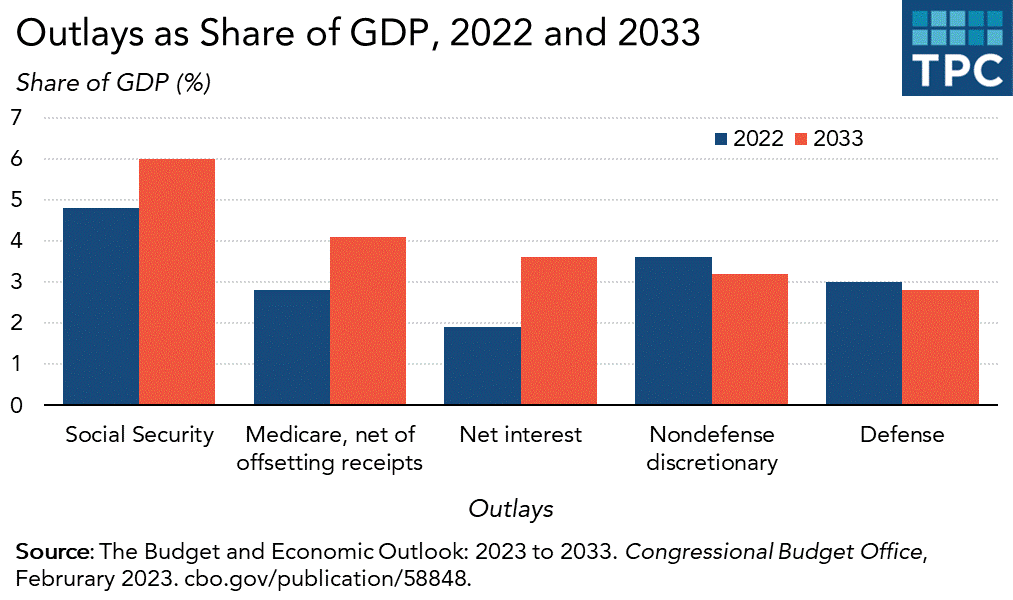The Congressional Budget Office estimates the national debt will increase by $19 trillion over the next decade under current law, $3 trillion more than it projected last May. But for all the squawking in Washington over how to deal with deficits and debt, nearly all of the increases will come in spending Congress and President Biden seem unwilling or unable to touch.
Overall, the debt will rise from about 97 percent of the Gross Domestic Product (bad enough) to 118 percent of GDP, a level unseen since World War II.
The “untouchables”
The biggest causes for CBO’s new estimates are these “untouchables.” Higher-than-expected wages will boost Social Security payroll taxes, but faster inflation will increase benefits by about $400 billion more than CBO figured just last May. CBO also expects spending to rise more than previously anticipated for veterans’ health benefits, which Congress just increased, and for defense spending, which big bipartisan majorities in Congress have been raising and most want to hike even more.
CBO now figures the widening gap between payroll tax revenues and Social Security benefits means the Old-Age and Survivors Insurance (OASI) trust fund will be exhausted in 2032, a year earlier than the most recent projection by the Social Security actuaries.
As the population ages and medical costs increase, Medicare is expected to spend $15 trillion over the next decade to pay doctors, hospitals, skilled nursing facilities and other providers. The only glimmer of good news is CBO raised its estimate of Medicare spending by only $85 billion. One reason: Last year, Congress voted to allow Medicare to take steps to hold down the prices of some drugs.

The debt
Then, there are those interest payments. CBO projects net interest will roughly triple, from $475 billion, or 1.9 percent of GDP, in 2022 to more than $1.4 trillion, or 3.6 percent, in 2033 alone.
Part of the reason will be higher interest rates. CBO estimates the government will pay an average rate of 3.2 percent on its debt in 2033, compared to 2.1 percent last year. But the biggest culprit is the debt itself will be so big. More than $46 trillion a decade from now.
Congress can’t do anything about those interest payments. Well, it could drive them to stratospheric levels by defaulting on the debt, an event CBO projects will happen this summer without congressional action. But it can’t reduce the projected debt unless it cuts spending or raises taxes.
But Biden and the Democrats won’t touch Social Security and Medicare, and seem to have outmaneuvered Republicans, who a month ago vowed to cut those programs but now deny they ever said such a thing. Nobody will cut military spending while the Russians are in Ukraine and China grows as a threat. And Republicans are dead set against any tax increases.
What’s left
That leaves spending that isn’t Social Security, Medicare, the military, and interest payments. There is Medicaid, the Children’s Health Insurance Program (CHIP) and Affordable Care Act (ACA) health insurance subsidies. And there are the hundreds of domestic discretionary programs that most Americans think of as government-- programs such as border and homeland security, farm aid, national parks, the FAA, education, and the like.
Federal support for the state/federal Medicaid program has been growing in recent years. Much of that money goes to provide health care for children, young people with disabilities, and frail older adults getting care in nursing facilities and at home. The feds pay the biggest share of costs in poor red states. We’re not likely to see much cutting there.
The rest is a relatively small, and shrinking, piece of the federal government. CBO estimates this so-called nondefense discretionary spending will fall from 3.6 percent of GDP to 3.2 percent in 2033.
No help from taxes
The nation’s balance sheet won’t be helped much by tax revenues. CBO expects individual income tax receipts will fall from their historic highs in 2022, mostly because capital gains taxes will decline, thanks to last year’s awful stock and bond market returns.
Keep in mind CBO is required to make assumptions based on current law, no matter how improbable. Thus, it projects income tax revenues will rise after 2025, when all the of individual income tax provisions of the 2017 Tax Cuts and Jobs Act (TCJA) expire. If that happens, individual income taxes will increase from about 8.8 percent of GDP in 2025 to roughly 9.6 percent thereafter. But if Congress retains all of those provisions, TPC figures it would reduce projected revenues by more than $3 trillion.
Lawmakers say they want to reduce the deficit. But the CBO report shows both how daunting the challenge is and how narrow their target for achieving that goal is.
